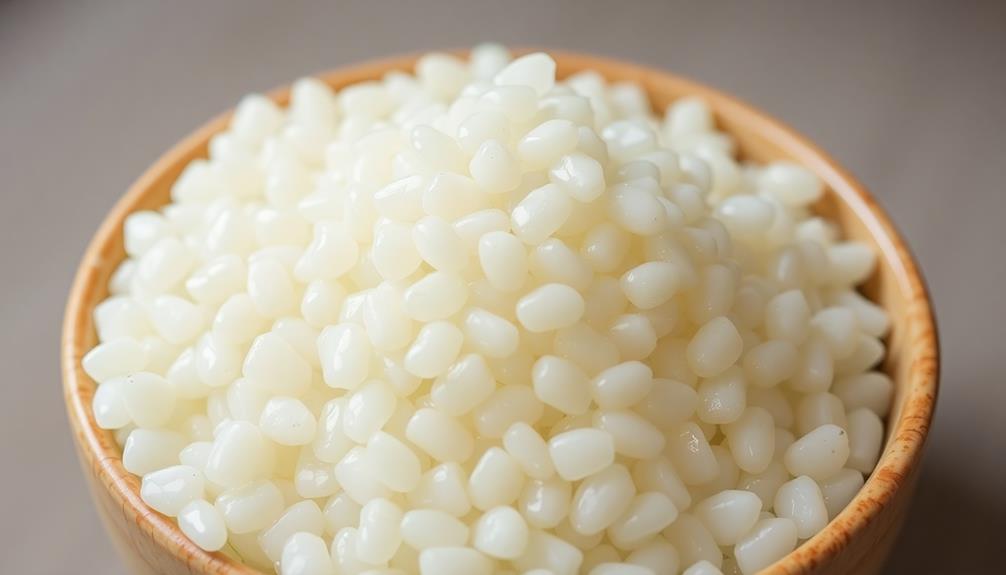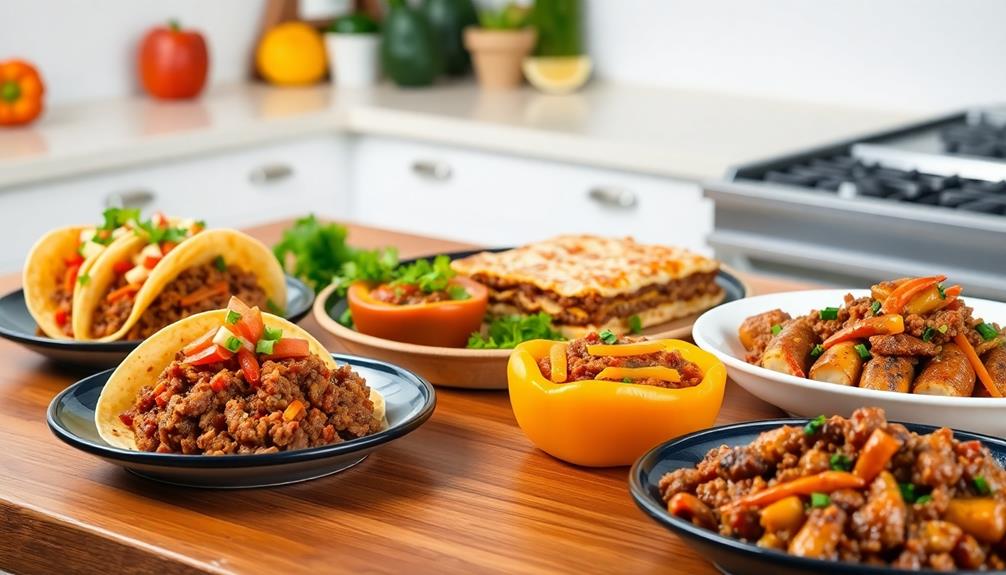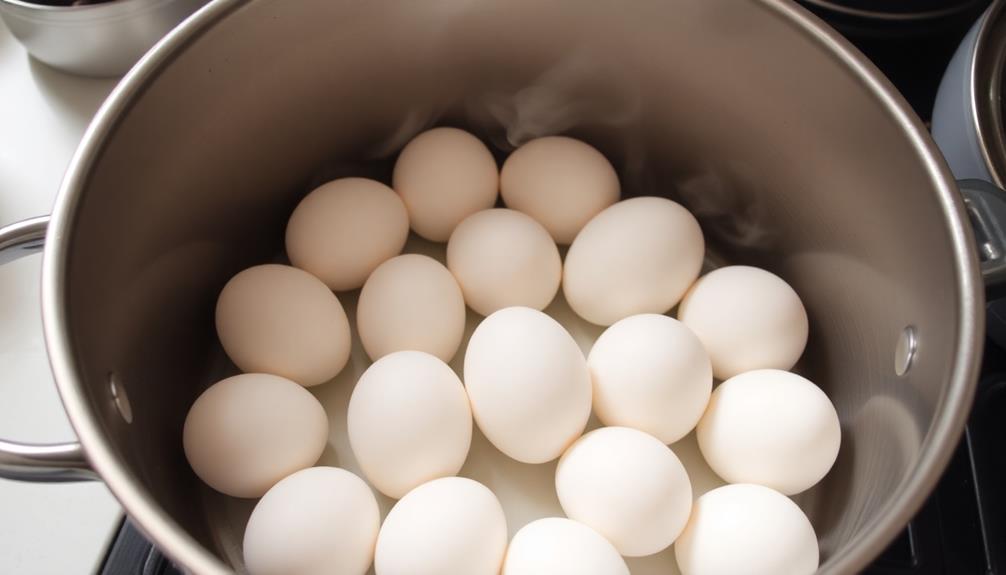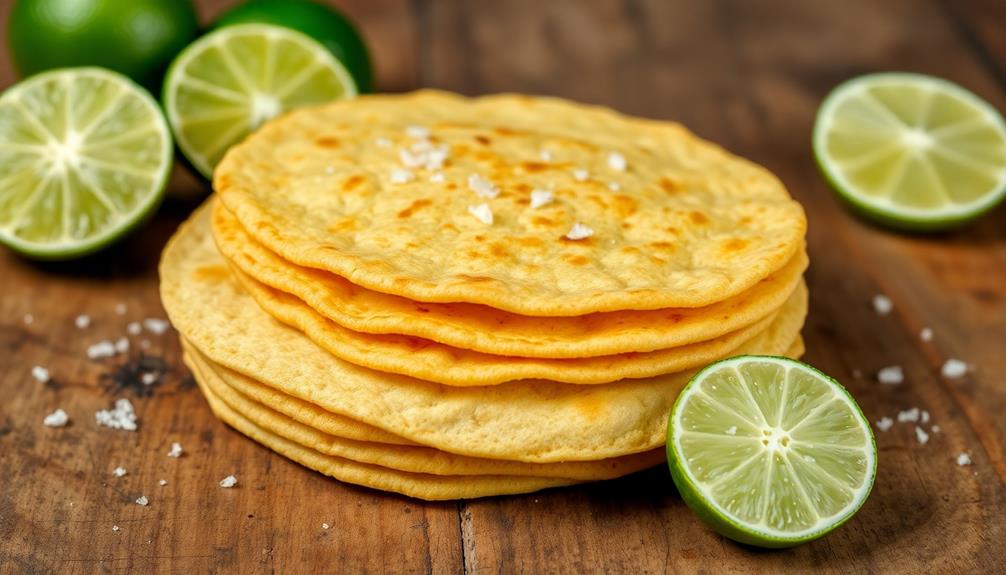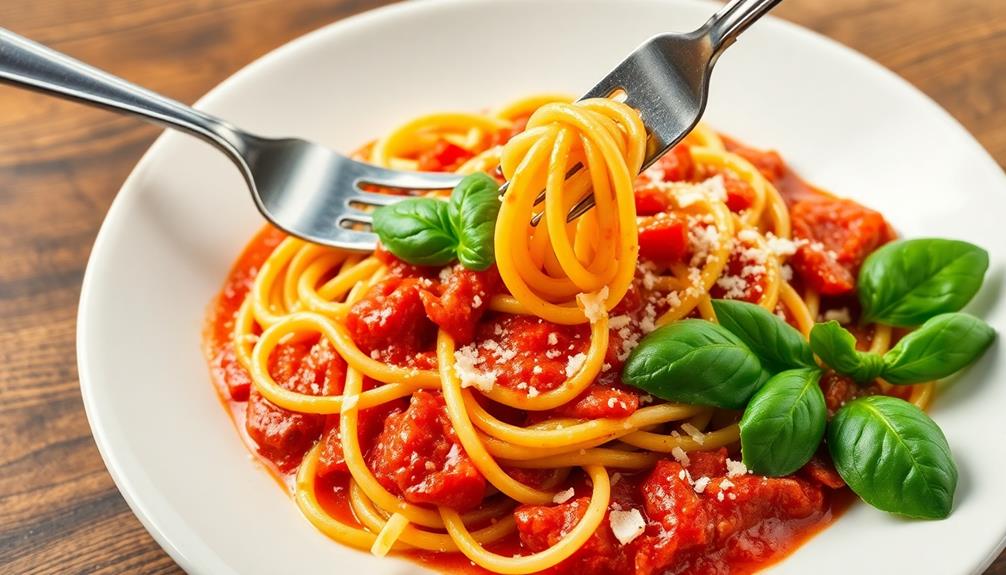You can make perfect white rice right at home with just a few simple steps. First, rinse the rice thoroughly to remove excess starch. Then, use the right water-to-rice ratio and let it simmer untouched. Once cooked, fluff the rice with a fork to achieve a light, fluffy texture. You can even add seasonings or broth to kick up the flavor. Mastering these basic techniques is the key to cooking delicious white rice every time. And with a bit of practice, you'll be whipping up restaurant-quality rice dishes in no time.
Key Takeaways
- Rinse rice thoroughly to remove excess starch and achieve a fluffy texture.
- Maintain the proper 2:1 water-to-rice ratio for consistent results.
- Avoid lifting the lid during cooking to retain steam and moisture.
- Let the cooked rice rest for 5-10 minutes to finish cooking and absorb moisture.
- Fluff the rice gently with a fork to separate the grains and prevent stickiness.
History
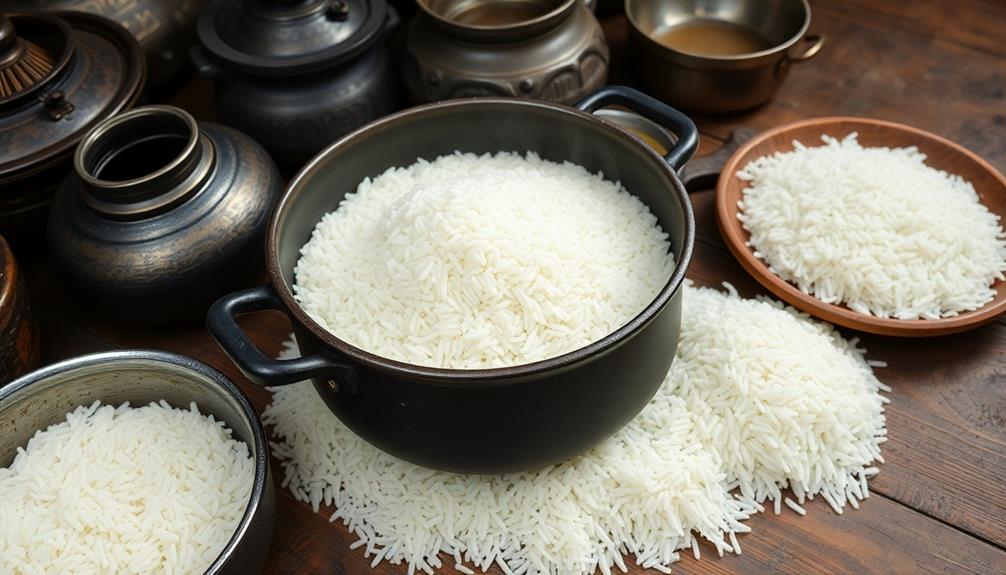
Rice has been a staple food for centuries, with evidence of its cultivation dating back thousands of years. From ancient China to the Fertile Crescent, this versatile grain has played a central role in diverse cultures and cuisines.
Over time, the methods of growing and preparing rice have evolved, but its fundamental importance to human sustenance remains unchanged.
In many parts of the world, rice is more than just a meal – it's a way of life. Generations of farmers have perfected the art of cultivating this crop, adapting to local climates and traditions.
The history of rice is rich with stories of innovation, adaptation, and the human drive to nourish ourselves and our communities.
As you delve into the world of perfect white rice, you'll uncover a tapestry of culinary history that spans continents and centuries. This humble grain has captivated the hearts and palates of people everywhere, and its story is just beginning.
Recipe

Cooking the perfect white rice is a simple yet essential skill in the kitchen. The key to achieving fluffy, evenly cooked grains lies in the proper ratio of water to rice and the right cooking method.
White rice is a versatile staple that can be used in a wide range of dishes, from savory stir-fries to comforting risottos. Whether you're a seasoned home cook or a beginner, mastering the art of cooking white rice will elevate your culinary repertoire.
Ingredients:
- 1 cup long-grain white rice
- 1 1/2 cups water
Instructions:
Rinse the rice in a fine-mesh strainer until the water runs clear. This step removes excess starch and helps achieve a more separated, fluffy texture.
In a medium saucepan, combine the rinsed rice and water. Bring the mixture to a boil over high heat. Once boiling, reduce the heat to the lowest setting, cover the pan with a tight-fitting lid, and simmer for 15-18 minutes, or until the rice is tender and the liquid has been absorbed.
To ensure the perfect white rice, avoid lifting the lid during the cooking process, as this can release valuable steam and disrupt the cooking.
Once the time is up, remove the pan from the heat and let it sit, covered, for an additional 5-10 minutes. This resting period allows the rice to finish cooking and any remaining moisture to be absorbed. Fluff the rice with a fork before serving.
Cooking Steps

First, you'll want to rinse the rice until the water runs clear.
Then, simply add the rice and water, bring it to a boil, and reduce the heat to let it simmer, covered.
Once it's done, remove the lid and fluff the rice with a fork to finish it off.
Step 1. Rinse Rice Until Water Runs Clear
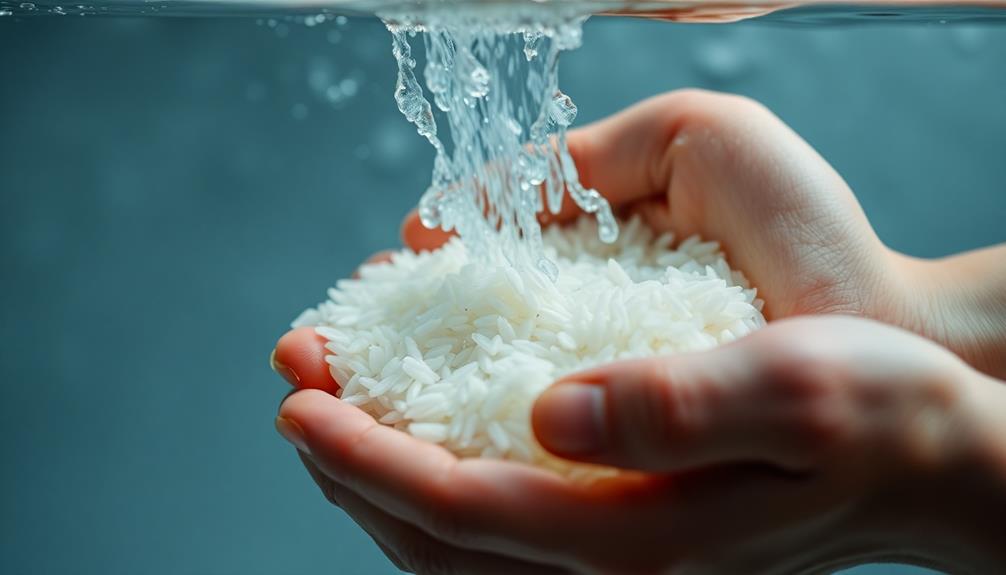
Rinse the rice thoroughly under cool running water until the liquid appears clear. This simple step removes any excess starch that could make the rice sticky or gloppy. Gently swish the rice with your fingers as the water runs through, making sure to disturb the grains as little as possible.
You'll know the rice is ready when the outgoing water looks crystal clear, without any milky cloudiness.
Rinsing rice is an important technique that helps achieve that perfectly fluffy, separate texture. It's a quick process that takes just a minute or two. Be gentle and patient – you don't want to break the delicate grains.
Once the water runs clear, the rice is ready for the next step in cooking up a batch of perfect white rice. This simple prep work sets you up for success, ensuring your final dish turns out light, tender, and truly delicious.
Step 2. Add Rice and Water

Once you've rinsed the rice, it's time to add the water. Use a medium-sized pot with a tight-fitting lid. For every cup of rice, add 1 1/2 cups of water. So if you're cooking 2 cups of rice, you'll need 3 cups of water.
Gently pour the rice into the pot, then slowly add the water. Be careful not to splash or spill.
Give the rice and water a gentle stir to ensure the rice is evenly distributed. Then, place the pot over high heat and bring it to a boil. Once it reaches a boil, immediately reduce the heat to the lowest setting, cover the pot with the lid, and let it simmer.
Resist the urge to lift the lid and peek – that lets out valuable steam. Simmering the rice for 15-20 minutes will result in perfectly cooked, fluffy grains.
Once the time is up, remove the pot from the heat and let it sit, covered, for an additional 5-10 minutes before fluffing and serving.
Step 3. Bring to a Boil
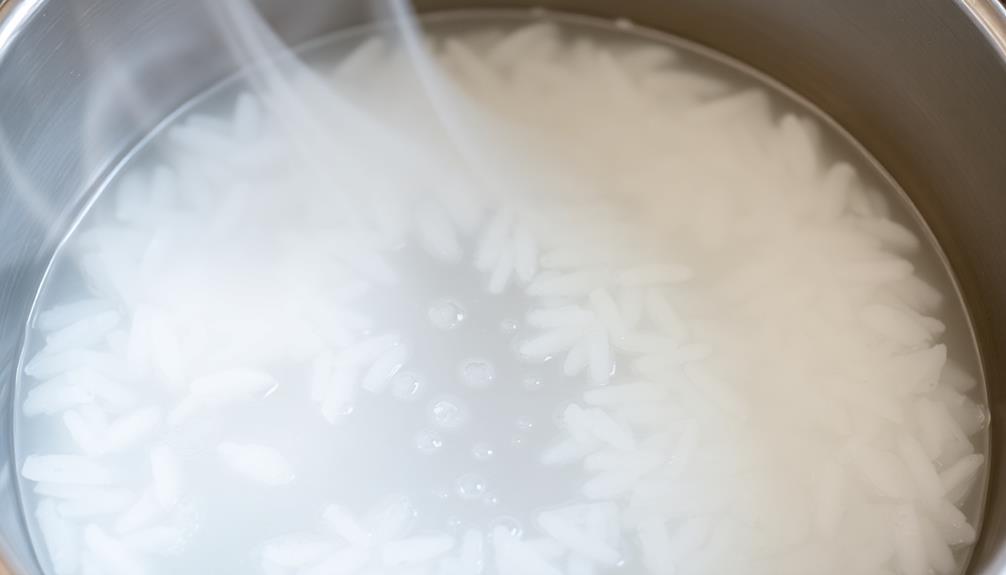
Bringing the pot to a boil is the next crucial step. Turn the heat up to high and keep a close eye on the pot.
You'll soon see small bubbles forming around the edges, signaling that the water is heating up. Once those bubbles start rapidly breaking the surface, you'll know the water is at a full, rolling boil. This is the perfect temperature for cooking rice.
At this point, give the rice a quick stir to make sure none of the grains are sticking to the bottom. Then, reduce the heat to low, cover the pot with a tight-fitting lid, and let the rice simmer.
Avoid lifting the lid during this time, as that allows valuable steam to escape. Trust the process and let the rice cook undisturbed for the recommended time on the package.
Soon, you'll have perfectly cooked, fluffy white rice ready to enjoy.
Step 4. Reduce Heat, Cover, and Simmer
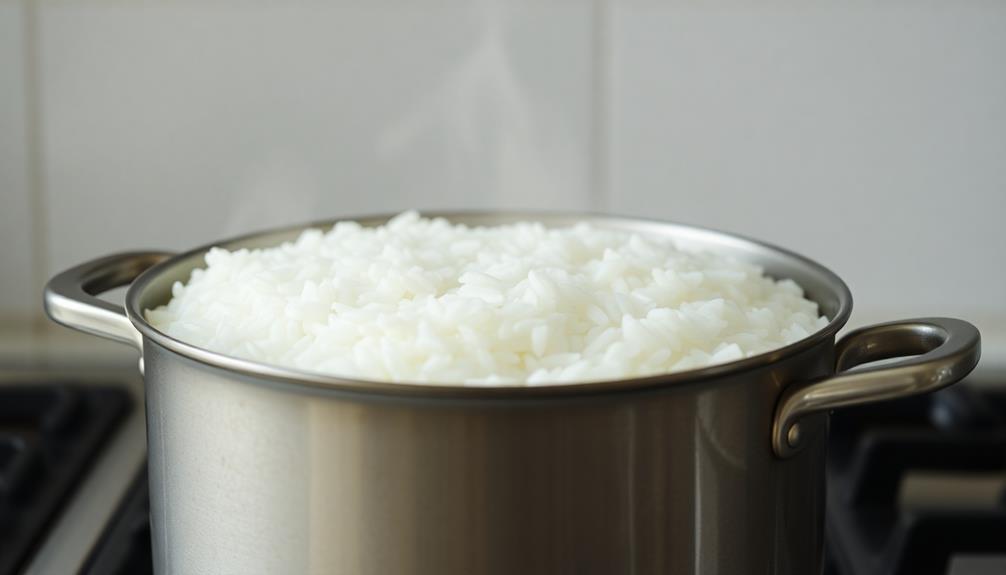
Next, reduce the heat to low, cover the pot with a tight-fitting lid, and let the rice simmer.
This gentle heat setting will allow the rice to cook through without overcooking the exterior. As the rice simmers, the liquid will slowly be absorbed, resulting in perfectly cooked, fluffy grains.
Set a timer for 15-20 minutes, depending on the amount of rice you're preparing. Resist the urge to lift the lid and peek – this releases steam and disrupts the cooking process.
When the timer goes off, turn off the heat but keep the lid on for an additional 5-10 minutes. This resting period allows the rice to finish cooking and the grains to separate.
Fluff the rice with a fork before serving. With a little patience and the right technique, you'll have restaurant-quality white rice in no time.
Step 5. Remove Lid, Fluff With Fork

After the rice has simmered for the allotted time, it's time to remove the lid and fluff the rice. Grab a fork and gently fluff the rice by running the tines through the grains. This step is crucial for creating light, fluffy rice.
Be careful not to overmix, as this can make the rice sticky. Once the rice is fluffed, let it rest for 5-10 minutes with the lid off. This allows any remaining moisture to evaporate, ensuring your rice is perfectly cooked.
During the resting period, resist the urge to peek or stir the rice. Letting it sit undisturbed allows the grains to fully separate and develop that desired tender, yet distinct texture.
After the resting time, your rice is ready to serve. Fluff it one more time with the fork before scooping it into bowls or onto plates. Enjoy your perfectly cooked white rice, ready to pair with your favorite dishes!
Final Thoughts
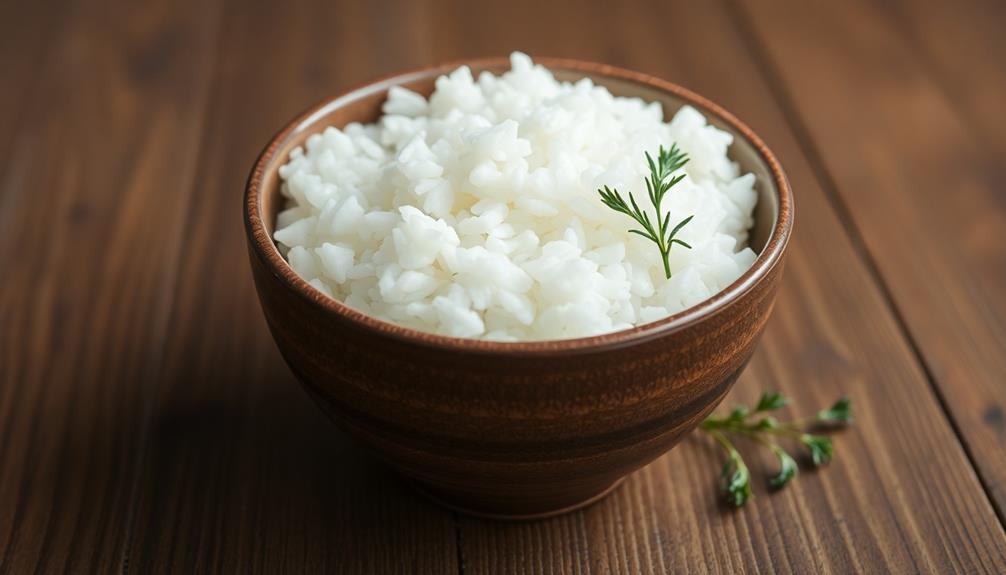
Mastering the art of cooking perfect white rice is a rewarding journey. With the right techniques, you'll be serving up fluffy, delicious rice every time. Don't be intimidated – the process is straightforward, and you've got this!
The final step is to let the cooked rice sit for a few minutes before fluffing and serving. This allows the grains to firm up and the flavors to meld together.
Use a fork to gently fluff the rice, being careful not to overmix and make it sticky.
Your perfectly cooked white rice is now ready to enjoy as a simple side or as the base for all sorts of delicious dishes. Savor the satisfaction of creating something so simple, yet so satisfying.
With practice, you'll become a rice-cooking pro, impressing family and friends with your culinary skills. Embrace the process, and get ready to elevate your meals to new heights.
Frequently Asked Questions
How Long Can Cooked White Rice Be Stored in the Refrigerator?
You can store cooked white rice in the refrigerator for 3-5 days. Keep it in an airtight container and reheat it thoroughly before serving to ensure food safety and prevent bacterial growth.
Can I Use a Rice Cooker Instead of a Pot for Cooking White Rice?
Yes, you can use a rice cooker instead of a pot for cooking white rice. Rice cookers are designed to automatically cook and keep the rice warm, making it a convenient and effective method for preparing perfect white rice.
Is It Necessary to Rinse the Rice Before Cooking?
Rinsing the rice isn't always necessary, but it can help remove excess starch and improve the texture. Try rinsing the rice a few times until the water runs clear if you prefer a fluffier result.
What Is the Best Way to Reheat Leftover White Rice?
To reheat leftover white rice, you can use the microwave or a skillet on the stovetop. Sprinkle a bit of water over the rice, cover, and heat until warm and fluffy. Avoid letting it dry out.
Can I Substitute Brown Rice for White Rice in This Recipe?
You can certainly substitute brown rice for white rice, but the cooking time and method will differ. Brown rice takes longer to cook and has a nuttier, chewier texture compared to the fluffy, light white rice.

